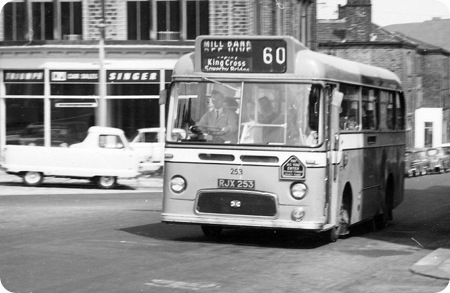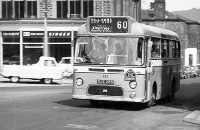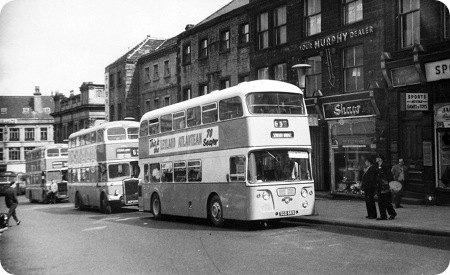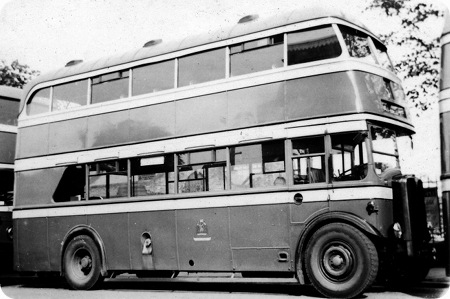Halifax Corporation – Albion Nimbus NS3AN – RJX 253 – 253

Photograph by ‘unknown’ if you took this photo please go to the copyright page.
Halifax Corporation Transport and Joint Omnibus Committee
1963
Albion Nimbus NS3AN
Weymann B31F
Halifax acquired ten of these little Albion Nimbus to do a few routes that due to the narrowness of the roads and sharpness of the bends a small bus was required for the job. These buses suited the bill fine size wise but that was about all. With its rather small engine 4.1 litre I think climbing the Pennine hills was quite a chore and as they were noisy on the flat you can imagine the noise on the climb up from Hebden Bridge to Heptonstall. It has also come to light that they were not all that reliable in a few other ways too. They must of been really bad as 2 went in 65, 2 more in 66 and all the rest by 67 a 4 years life span is not good.
Halifax General Manager Geoffrey Hilditch wrote a series of magazine articles called "Looking at Buses" under the pen-name Gortonian, one of which was about the Albion Nimbus. I’m not saying there weren’t reliability problems, but as I recall it, the main problem at Halifax was a more general operational one. At a time when there was a general shortage of serviceable vehicles, anything that was available and working needed to be able to go anywhere, not be restricted to certain duties because it only had 31 seats. I think that’s why they had to go.
Peter Williamson
They had to go because they were truly dreadful for reliability, they were replaced with the special short narrow Pennine bodied AEC Reliances
Christopher
A coincidence (not) that Great Yarmouth’s six Nimbuses were replaced by short Reliances with Pennine bodywork? Not really GH was GM at Caister Road too.
One of the latter vehicles (85) has been wonderfully restored by the East Anglian Transport Museum.
Mick Capon
Several of these Halifax buses served with Wiles as the backbone of their short services from Tranent to Prestonpans and Port Seton well into the 1970s. They stood out as the sole surviving independent bus operation at that time in the Edinburgh area, and the Nimbuses provided an interesting variation on the usual fare!
John Godfrey
Christopher’s comments on the Albion Nimbus reminded me of a short tale, (anecdotal, so I don’t guarantee its total accuracy), about the reliability of these vehicles. Maidstone & District bought a small number of them to use on light rural routes, and they had a dreadful reputation. The Chief Engineer, allegedly, made a derogatory remark about the ability of the Central Works to overhaul the engines properly, and got one that had been rebuilt by his former company, Western Welsh – that much is certainly true; I remember seeing it at Postley Works. A little later, after I had moved to a different department, I asked a friend who worked at Postley how they had got on with it. ‘It ran relatively well’, was the reply. ‘It managed about twenty feet outside the works door before breaking down!’
Roy Burke
29/05/11 – 07:00
When Mr Hilditch then at Great Yarmouth heard that Mr LeFevre was buying Albion Ninbii he offered the Great Yarmouth batch and begged him to reconsider but to no avail, it was shortly after this that Mr. Hilditch returned to Halifax to find his newest buses to be these 10.
Christopher
31/05/11 – 18:47
RJX 253 and 256 ended up with Baddeley Bros. of Holmfirth for use on their rural routes. 253 lasted long enough to pass to West Yorkshire PTE, as a withdrawn vehicle, with the Baddeley’s business in 1976.
I also remember going to see one of the others operating with Wiles, but can’t remember which one, possibly RJX 252
Eric
26/09/11 – 06:34
Ramsbottom Urban District Council became the owner of RJX 258 having acquired it from Warrington Corporation in 1967. It was given fleet number 12 and used on the infrequent service to Holcombe Village. When RUDC was absorbed into SELNEC PTE in 1969 the bus became SELNEC 6082, a picture of it on the service to Summerseat appears at: www.flickr.com/photos/
Summerseat had a railway station but no bus service until the railway closed. Due to the tight access to the village the Nimbus proved useful. Later alternatives were the similar sized Seddon Pennine midi buses one of which, on the Holcombe Village service, appears at: www.flickr.com/photos/
David Slater
28/07/14 – 07:40
Mention of the Hebden Bridge-Heptonstall route prompts the question:
When did they stop doing the hairpin turn into and out of the hill to Heptonstall and install the turning circle further along towards Todmorden?
John Lomas
29/07/14 – 06:32
When I was a Halifax Traffic Clerk in 1964-66, I gained my PSV licence in February 1965, and then worked most evenings and Saturdays covering shifts on the road. Probably uniquely in HPTD, I loved the little Nimbus and became the first to be called upon when a Heptonstall duty needed covering – the regular road staff always steered clear as far as possible. The 46 route had an unbelievably tight reversing terminal point at Heptonstall – even the mirrors had to be folded back to get the bus off the narrow Towngate into the tiny gap between buildings – and, for this reason, the little Nimbuses on this service carried conductors to guide the driver into the constricted aperture. Later, when standard saloons replaced the Nimbuses, the route was diverted to run round the (then) council estate. Why this could not have been accomplished earlier, I cannot comprehend. Perhaps there was a Road Service Licence problem. At Hebden Bridge, as John Lomas has indicated, the Heptonstall Road descends steeply down to a very acute west facing junction with the A646 in the Calder valley. It was just possible (but officially frowned upon) to crank a Nimbus hard right from the main road into Heptonstall Road and up the hill, a manoeuvre that I now see (from Google Earth) is prohibited. Also, I don’t recall there being traffic lights at this point back in the ‘sixties. Returning from Heptonstall, one had no option but to continue along the A646 and swing round where the roadway widened near Church Lane. This was the official recommendation for both directions, and when standard saloons took over the route, no other option was possible. I haven’t visited this area for a great many years now, but, looking at this junction on Google Earth, I am amazed how little has changed in half a century. Even most of the distinctive houses on the steep valley side, with their first floors at the front becoming the ground floors at the back, are still there.
Roger Cox
29/07/14 – 17:39
As Roger says, the official (and in most cases the only possible way) to make the turn into Heptonstall Road was to proceed past, pull over onto the righthand side of the road, reverse into Church Lane, then return back along the road to what was then just a left fork. This applied to both the HJOC’ Heptonstall route and Hebble’s 15 Burnley.
I have no record of when the Mytholm turning-circle was constructed. Though I started driving Halifax Corporation buses in 1973 I do not recall driving buses that far ‘down the valley’ (strictly speaking, it’s ‘up the valley’ – but that’s the local terminology !) until about 1980, and by then it had been in operation for quite a while. I would suggest it was opened in the early 1970’s.
John Stringer
30/07/14 – 06:49
I was hoping John S might know when the turning circle was built as I have an undated print showing it in use.
Geoff Kerr
30/07/14 – 08:28
Roger- you seem to have a dawning realisation in recent posts about Halifax that it is a place where NOTHING CHANGES, an endearing or infuriating feature of the real west Yorkshire. The inconsistency is the adventure in bus purchases, as you would have expected them to be ordering Titans for ever- like, dare I say, Todmorden "up" the Valley. (There is something Biblical in the way you are said to travel from Halifax (Jerusalem) down to Todmorden (Jericho). Apart from Mr Hilditch’s influence, many purchases show an underlying respect for nature- steep hills, ancient, narrow lanes, cold winters- although where rear engines fit into this I’m unsure. It is said that Halifax has retained a fine Victorian centre because no-one could agree on redevelopment, although another fault in the theory they couldn’t resist a bit of peripheral highway-in-the-sky. Perhaps in this and the Fleetlines etc old fashioned civic pride has to be added to the mix. Another thought: about the time of WYPTE the districts did take up some new liveries before the rather anaemic eau de nil and then the naffly-named and liveried Yorkshire Rider. Calderdale, if I recall was Royal Blue with yellow? Kirklees was to keep red, but the other two?
Joe
30/07/14 – 13:36
Having consulted with a friend who lived nearby the Mytholm turning circle, who has in turn consulted a colleague who drove for Halifax Corporation in the early to mid-sixties (probably simultaneously with Roger Cox at one point) the latter reckons it may have opened as early as 1964 ! Any more offers ?
Regarding the liveries from the PTE onwards. Shortly before WYPTE took over, a bus from each district was experimentally turned out in a suggested new livery, with different colours in a common layout. These were mostly cream but with a band around the lower half of the skirt panels and the roof and top-deck window surrounds painted in a district colour that related to the previous municipalities – green for Leeds, blue for Bradford, red for Kirklees (Huddersfield) and orange for Calderdale (Halifax). The idea was rejected however.
Then Geoffrey Hilditch repainted seven Halifax vehicles (three Fleetlines, two PD2’s, a Reliance and a Todmorden Leopard) in a scheme of his own, consisting a darker green and cream but all applied in different layouts, and with a ‘Metro Calderdale’ fleetname enclosed in an orange losenge shaped rather like a coffin! What was he implying ? Despite all GGH’s rather cheeky efforts, the idea was also rejected. The final universal livery of Verona Green and Buttermilk was actually based on that used on the three Plaxton Elite-bodied Leopard coaches delivered to Leeds City Transport in 1973.
The post-deregulation Yorkshire Rider livery of green and cream was in many ways not unlike GGH’s 1974 offerings but with very large and gaudy red fleetnames added. Badgerline Holdings took over briefly and added rather childish smiley badgers to lurk behind the rear wheelarches.
FirstBus at first allowed each district to devise their own individual liveries and fleetnames. Leeds went for a a sort of pale beige with red, orange and yellow stripes (very similar to a contemporary petrol tanker livery if I recall ?) with the name ‘Leeds City Link’. Bradford went for two shades of blue and red, with an unbelievable number of layout variations, and chose to be ‘Bradford Traveller’. Huddersfield chose two shades of green (the darker shade being the same as the old YR green) and red, and the ‘Kingfisher’ identity. Halifax chose a startling mostly white livery, with Ford Tractor blue and Sunburst Yellow lower bands that turned up sharply towards the rear, and the name ‘Calderline’.
Shortly after, First devised the now familiar corporate pale grey (or dirty off white ?), blue and pink livery and decreed that this should be applied to all new vehicles. The local liveries were soon abandoned and the hideous corporate simplified ‘Barbie 2 fade out pink’ vinyls were applied to the older buses – the absolute nadir as far as I am concerned.
These vinyls obviously seemed like a good idea to someone with actually no idea. They took the form of one very long and expensive roll of vinyl transfer that was to wrap around the entire lower section of the bus. Maybe this type of thing was practical on large slab-sided vans, but fitting them around all the corners, and cutting them around all the doors, wheelarches, panel beading, radiator, diesel and other access flaps, ventilation grilles, light fittings etc. was an utter nightmare for the two bodyshop chaps who would have to struggle manfully for up to two days with scissors and a hot air gun applying them. Before long the bus wash, weather and accidental scrapes would soon cause them to peel and become grubby and ingrained with dirt, and if a panel had to be replaced then a new bit would have to be cut from a roll and stuck on – though sometimes they didn’t bother at all and just painted them in, the painter becoming quite adept at recreating the ‘fading out’ effect with his paintbrush ! What had it all come down to ?
John Stringer
31/07/14 – 06:21
Sounds then as if I have my reliverying backuds way on, then, John. Hardly surprising in the general chassis.
In the fourth district, life was simpler: National poppy disappeared and West Riding Green reappeared with a swervy swatch and more cream. Now Deutsche Bahn fiddle and refiddle with their over fussy liveries.
Joe
31/07/14 – 18:05
The NBC and some of the PTE liveries may have been pretty naff, but the present day crowd are in a class of their own. Now that it has finally swallowed Norfolk Green (after an ‘arms length’ connection for some time, I would guess) buses are appearing in a "Stenningised" version of the livery that has the front three quarters of the bus in grey. Norfolk Green is now Norfolk Grey. One extraordinary comment on the Anglia Bus Forum (I am not a member!) is:- "Looks to me that Ray Stenning has been used, which is never a bad thing". Words fail me.
Roger Cox
11/08/14 – 07:12
The "Kingfisher" livery of two shades of green (applied in manner not unlike naval "dazzle camouflage") adopted, as John writes, by Yorkshire Rider Huddersfield was actually the last corporate Yorkshire Rider livery: Bradford, Halifax and Todmorden, and Leeds all adopted new identities as described (identities being spot-on in the case of Bradford Traveller – there were [?three] trial versions before a "final" application was chosen . . . that then turned out to be less-than-final as further simplifications followed) but Kingfisher adopted the final Yorkshire Rider scheme as it had just had a large injection of new vehicles which it didn’t want to repaint. I do remember a lot of adverse comment in the letters pages of the local press about the adoption of "Kingfisher" instead of "Yorkshire Rider Huddersfield" as the trading name (the locals wanted to see Huddersfield on the sides of their buses, and thought "Kingfisher" was meaningless), the response was a lot of blather about "Kingfisher" representing something dynamic/colourful/resilient (I’m assuming Chris Youhill doesn’t read the Huddersfield Examiner, or he’d have had a heart attack) . . . eventually "Kingfisher Huddersfield" was adopted to placate local opinion.
In my opinion liveries are routed in what the French call "terroir": they are part of, and they define their localities – here in Aireborough (Yeadon/Rawdon/Guiseley) we were served by the red buses of WYRCC (OK Chris . . . and the blue buses of Ledgard) but not – unless you want to go back a bit – the blue/green buses of Leeds City Transport (forget the short-lived Cookridge-Morrisons shoppers service) and that set us apart. You meddle with liveries at your peril: Aberdare/Cynon Valley’s maroon might have been a bit dour, but Geoffrey Hilditch’s imposition of Halifax/Calderdale’s dual-purpose application of green/white/orange had no connection locally.
And finally. I’ve thrown it out, and I can’t remember where I saw it, but it was a very recent "back in those days" article about Halifax’s first female driver – "Yorkshire Post"? "Yorkshire Reporter"?. The 23-year-old ex-conductress was pictured smiling at the wheel of one of Halifax’s Daimler Fleetlines: oh dear! that smile would soon be wiped-off her face when, 30 min after starting out on her first "9 Raw Lane" journey, half the town’s buses were off the road in protest. Apparently Sarah(? – I think I’ve got her name right) was then returned to conducting duties whilst arbitration was carried out. The atmosphere at the Sixth Form College where I teach can be toxic at times (actually, is toxic most of the time(), but this is in a different league.
Philip Rushworth
11/08/14 – 09:56
Halifax Corporation’s first female driver was called Sandra Holt. As Philip says, the matter caused quite a furore at the time and she left the department very soon afterwards. Interestingly though a couple of years later in 1973 when the second female driver – Mavis Sayer – appeared on the scene, there was no problem whatsoever and she had nothing but support from her colleagues, finally retiring about five years back after 40 years service. After Mavis many more quickly followed suit, and I reckon that up to the present day the Corporation and its successors in Halifax have employed around 75 female drivers.
John Stringer
13/08/14 – 07:02
Sandra Holt! That’s her name – thanks John. I have to ask myself, is there something about bus/HGV-driving and ladies/women/females (oh God! what a minefield) that is problematical? The role of women in the Police and Armed Forces has been much expanded/integrated since I joined, and I had no problems subsequently working under female superiors . . . but if I see a bus or HGV driven by a female I still think (or even say to my family): "look! woman driver!!".
Philip Rushworth
15/08/17 – 08:05
Just a note on liveries for the then new PTE, Geoffrey Hilditch had as a first go four model Dinky toys Routemaster buses painted in four liveries, all essentially Halifax except for the panel between the windows, one was Halifax green, one Leeds dark green, one Huddersfield red and the other Bradford blue.
I think this was simply too traditional for the Board and too Halifax as well, after this came the painted buses with top and bottom the local colour, I recall the Halifax PD2 very well, was it nick named the ice cream van?
The eventual verona green had the Doncaster ‘roads and pavement’ strap round the front, GGH was not enthusiastic.
Christopher
 Vehicle reminder shot for this posting
Vehicle reminder shot for this posting
31/03/18 – 07:48
Sandra Holt, Halifax’s first female bus driver was mentioned earlier in this thread. I thought readers might like to know that there is currently a brief video clip of her, together with a view of the bus moving, in a short video on the BBC web site. It’s about a minute into the video
www.bbc.com/ideas/videos/the-glass-ceiling-smashers
(Sorry, I don’t know for how long it will remain on the site. I just happened to watch it and arrived here, searching for more information, because I was amazed that her fifteen minutes of "first woman" fame occurred less than fifty years ago!)
Jennifer H.
01/04/18 – 07:57
As an aside, the clip shows that those women who were employed by companies suffered discrimination, not from the employer, but from their colleagues, even to the point of striking in protest! They had a problem getting and retaining their jobs, let alone getting equal pay. Going back to pre-war days, women who got married were expected to give up work. My mother, a secretary in Hatton Garden, and married in 1933, used to take her wedding ring off and assume the mantle of remaining unmarried, until about June 1937, when her pregnancy with me would have started to show!
Chris Hebbron
01/04/18 – 07:58
Just about three-and-a-half-years after my post about Sandra Holt we get to see her in action – thanks Jennifer.
Philip Rushworth
Quick links to the - Comments Page - Contact Page - Home Page


